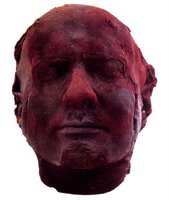 De Bolla's example of art throwing a spanner in the works of discourse is his account of Marc Quinn's Self. This is a sculpture of the artist's head made with nine pints of his own frozen blood.
De Bolla's example of art throwing a spanner in the works of discourse is his account of Marc Quinn's Self. This is a sculpture of the artist's head made with nine pints of his own frozen blood. I was reminded of this listening the other day to an account of Teresa Margolles's Instalación con Vapor, in which spectators enter a misty cloud made up, they soon learn, of water used to wash the dead in Mexico City's morgue. (More on Margolles, perhaps, anon.)
But there's no need to look simply at experimental or high art. Think for instance of the point at which the credits start rolling in the cinema, and the silence as you walk out of the building, before the commentary begins. We've been affected by the experience, but have yet to convert that affect into critique or analysis.
In these pauses all sorts of reactions are still possible. They constitute a temporality full of intensity, of incompossible articulations that have yet to be actualized. This is a silence that's far from empty.
We are normally suspicious of silence. Silence=Death. Silence is cowardice. Silence is the result of power's silencing.
But especially in the face of the hyperarticulacy that circulates in and around politics, the media, and the academy, it might be worth revalidating those brief pauses in which everything is still to be said, in which positions are yet to be taken. In which judgement remains in abeyance.
No comments:
Post a Comment